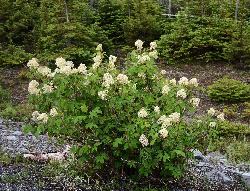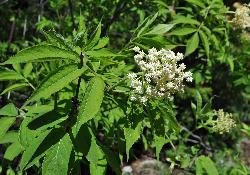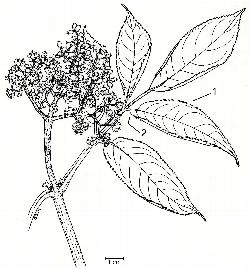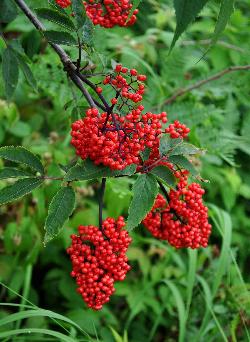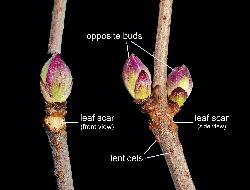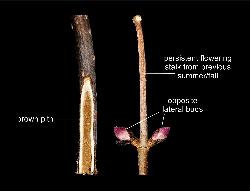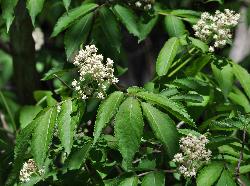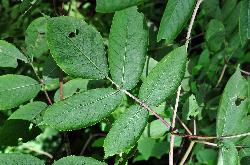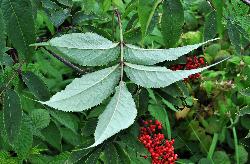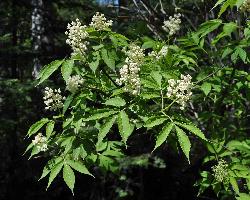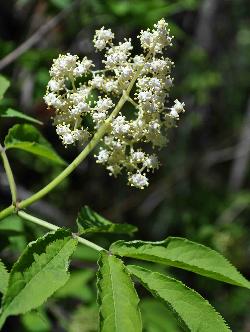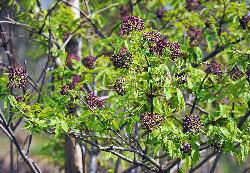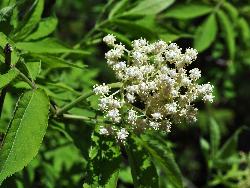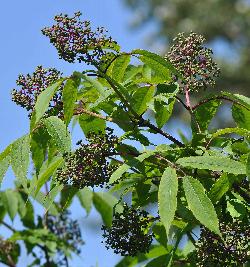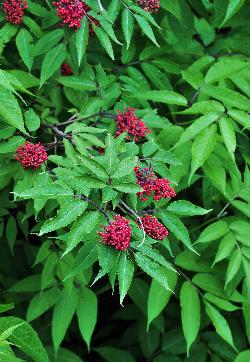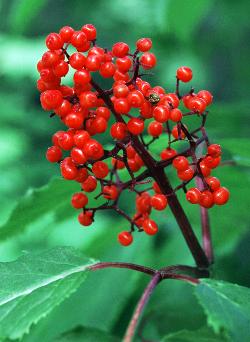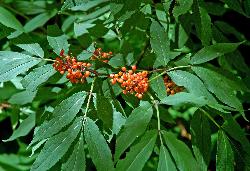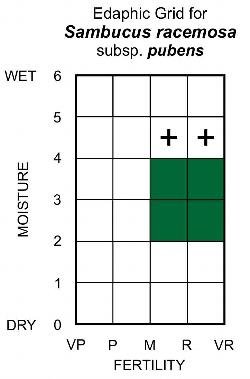Fr: sureau rouge, sureau pubescent
Viburnaceae - Viburnum Family
Note: Numbers provided in square brackets in the text refer to the image presented above; image numbers are displayed to the lower left of each image.
General: A coarse open deciduous shrub, to 4 m tall [1–3]. The flowers and leaves have a strong unpleasant odour, especially when bruised or crushed. Red elderberry is rhizomatous and often reproduces vegetatively through root sprouts (Fryer 2008), making it a useful shrub for slope stabilization (Gonzalves and Darris 2007). Its leaves and shoots may be browsed by moose and small animals, and the berries are eaten by a variety of birds. The variety of red elderberry native to Newfoundland and Labrador (var. pubens
Key Features: (numbers 1–2 refer to the illustration [4])
- Leaves are opposite and pinnately compound with 5–7 oblong to lanceolate leaflets.
- Leaflet bases are oblique, with the lower blade (below the midrib) longer than the upper blade.
- Fruits are small bright red drupes borne on purple pedicels and arranged in large branched clusters [5].
- Twigs are stout with prominent warty lenticels, and have large ovate purplish buds, large shield-shaped leaf scars, and a large reddish-brown pith [6–8].
Stems/twigs: Twigs are stout, reddish-brown to dark brown, with numerous raised lenticels; young twigs are initially downy, but become glabrous (glabrate) at maturity. The bark of older stems is greyish-brown with large warty lenticels [6]. Buds are opposite, large, and ovoid, with overlapping (imbricate) bud scales; the outer bud scales are dark brown, inner scales are purple to greenish; the leaf scar is large and shield-shaped, with 5 small vascular trace scars [7]. The pith is large and reddish brown [8]. Flowering shoots are determinate, with a pair of lateral bud developing at the base of the previous year's dead but persistent flowering shoot [8].
Leaves: Opposite, pinnately compound, with 5–7 leaflets [9–10], and petiolate; petioles are 2.5–5 cm long. Leaflets are dark green above and paler beneath [10–11], glabrous on both surfaces or downy-pubescent beneath, and 5–13 cm long by 2.5–5.5 cm wide. Lateral leaflets are oblong, lanceolate-ovate, or oblanceolate, very short-stalked, with rounded bases that are often oblique (the blade longer on the lower side of the midrib), narrowly-pointed (acuminate) apices, and sharply serrate margins. The terminal leaflet is oval to oblanceolate with a long stalk (petiolule); the blade tapers at the base and has a long acuminate apex.
Flowers: The bisexual flowers are small and numerous, arranged in a terminal, elongate, pyramid-shaped (pyramidal) inflorescence, a compound cyme, 5–13 cm long, on a long peduncle [12–13]. Flower buds are purple [14], fade to pink, and turn creamy white as the flowers open [15]. Individual flowers have a minute calyx, an open white corolla with 5 rounded reflexed lobes, 5 stamens, and a single pistil with an inferior ovary and 3 short stigmas. The central axis and branches of the inflorescence are initially green and finely pubescent, but become deep purple and glabrous as the fruits develop [16]. Flowers bloom in late spring to early summer. Pollination is by insects (entomophily) and by wind (anemophily) (Fryer 2008).
Fruit: Branched clusters of small, usually iridescent, red berry-like drupes [5, 17–18], 4–6 mm long, borne on purple pedicels; rarely, drupes may be orange [19], yellow, or white. The fruit are inedible and potentially toxic when raw, but edible when cooked and made into jams or wine. Fruits mature in late summer. Seed dispersal is by frugivorous birds and mammals (endozoochory) (Stutchbury et al. 2005).
Ecology and Habitat: Red elderberry is characteristic of moist to wet, nutrient-rich forests and alder swamps. While red elderberry can tolerate shade, it is usually most abundant in open forests and in early succession after windthrow, clearcutting, or fire.
Edaphic Grid: See image [20]: the Edaphic Grid for Sambucus racemosa var. pubens.
Forest Types: Red elderberry is most frequently encountered in the following forest types:
- Abietum rubetosum (Rubus-Balsam Fir Forest Subassociation)
- Aceretum galietosum (Galium-Mountain Maple Thicket Subassociation)
- Alnetum dryopteretosum (Dryopteris-Alder Swamp Subassociation)
- Betuletum typicum (White Birch-Mountain Alder Forest Subassociation)
Succession: Red elderberry can tolerate a wide range of light conditions and, while it can persist in mature forests, it is more abundant in open forests and early successional stages. The seeds, readily dispersed by birds and mammals, can also persist in the forest humus and later germinate after fire or harvesting. Some studies suggest that fire is important in breaking dormancy by scarifying the hard seed coats. It can also spread vegetatively through root sprouts, which grow more quickly than seedlings. While it responds rapidly to release, it rarely attains dominance after fire or cutting, instead, it occurs as small- to medium-sized patches with other seral shrubs (Fryer 2008).
Distribution: Red elderberry, native to North America and Eurasia, occurs sporadically throughout most of Newfoundland (Scoggan 1978), but is uncommon on the Northern Peninsula. It was thought to be absent from the Northern Peninsula, but a well-established shrub was located by the authors in 2015 along the highway near the St. Anthony Airport [1]. It was also previously unknown from Labrador until located in Red Bay (Hanel 2005a). On mainland Canada, it extends from Nova Scotia to the Yukon. In the United States, it occurs from Alaska south to California and, in the east, from Maine south to northernmost Georgia (USDA, NRCS 2016).
Similar Species: There are no other species of Sambucus native to Newfoundland and Labrador. Other shrub or tree species that have pinnately compound leaves include black ash (Fraxinus nigra Marshall), which has leaves with 7–11 sessile leaflets, and mountain ash (Sorbus) species, which have 11–19 sessile leaflets. The introduced European cultivar, golden elder (Sambucus canadensis 'Aurea') is often planted in Newfoundland communities, but does not naturalize. It can be recognized by its yellow pinnately compound leaves, flat-topped inflorescences, and dark purple fruit.


